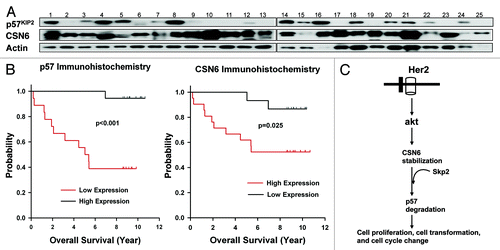Figures & data
Figure 1. CSN6 negatively regulates p57 stability. (A) HER2 and CSN6 negatively regulate the steady-state expression of p57. Equal amounts of cell lysates were immunoblotted with indicated antibodies. (B) CSN6 decreases the steady-state expression of p57 in a dose-dependent manner. 293T cells were co-transfected with indicated plasmids and increasing amounts of CSN6. Equal amounts of cell lysates were immunoblotted with indicated antibodies. (C) CSN6-mediated degradation of p57 is proteasome-dependent. 293T cells were co-transfected with the indicated plasmids. Cells were treated with MG132 for 6 h before harvesting. Equal amounts of cell lysates were immunoblotted with the indicated antibodies. (D) p57 turnover rate is decreased in CSN6-overexpressing cells. 293T cells transfected with the indicated plasmids were treated with cycloheximide (CHX) (100 µg/ml) for the indicated times. Cell lysates were immunoblotted with the indicated antibodies. Integrated OD values of p57 bands at each time point were measured using a densitometer. Levels of p57 at time zero were set at 100%. Remaining p57 is indicated graphically (right).
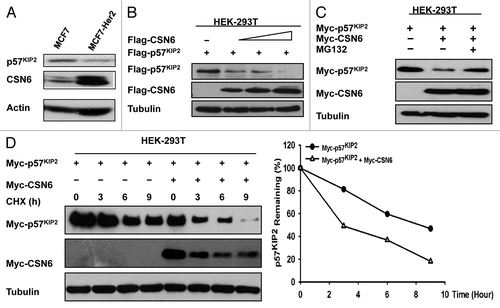
Figure 2. CSN6 is critical in affecting p57 ubiquitination. (A) CSN6 increases p57 ubiquitination in a dose-dependent manner. 293T cells were transfected with the indicated plasmids and increasing CSN6 expressing plasmids. The proteasome inhibitor MG132 was added 6 h prior to cell harvesting. The amount of ubiquitinated p57 was analyzed by immunoprecipitation (IP) with anti-Flag followed by immunoblotting (IB) with anti-ubi. TCE, total cell extracts. (B) CSN6 haplo-insufficiency leads to p57 stabilization. Indicated WT and csn6+/− MEF cells were immunoblotted with anti-p57 or tubulin antibodies. (C) CSN6 haplo-insufficiency leads to decreased p57 ubiquitination. Indicated MEFs were treated with proteasome inhibitor MG132 for 6 h prior to cell harvesting. The amount of ubiquitinated p57 was analyzed by immunoprecipitation (IP) with anti-p57 followed by immunoblotting (IB) with anti-ubi. TCE, total cell extracts.

Figure 3. CSN6 interacts with p57 through C-terminal domain. (A) Association between CSN6 and p57. HEK-293T cells transfected with indicated plasmids were immunoprecipitated with anti-Flag antibodies and immunoblotted with anti-Myc. TCE, total cell extracts. Cell lysates of HEK293 cells were immunoprecipitated with anti-CSN6 and then immunoblotted with anti-p57 for endogenous binding. (B) Mapping of p57 binding domains on CSN6. Indicated Flag-tagged CSN6 constructs were co-transfected with p57 into 293T cells. Cell lysates were immunoprecipitated with anti-Myc and immunoblotted with anti-Flag. Schematic representation of the mutants is shown. TCE, total cell extracts. (C) Mapping of Skp2 binding sites on CSN6. Indicated Flag-tagged CSN6 constructs were co-transfected with Skp2 into 293T cells. Cell lysates were immunoprecipitated with anti-Flag and immunoblotted with the indicated antibodies. (D) CSN6 does not interact with Skp2 on F-box domain. Indicated Flag-tagged Skp2 constructs were cotransfected with CSN6 into 293T cells. Cell lysates were immunoprecipitated with anti-Myc and immunoblotted with the indicated antibodies. TCE, total cell extracts.
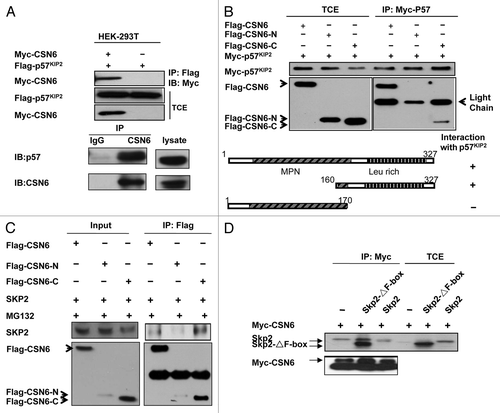
Figure 4. CSN6-mediated p57 downregulation is Skp2-dependent. (A) Skp2 deficiency diminished CSN6’s capability to reduce steady-state expression of p57. Indicated WT and Skp2−/− MEF cells after transfection with indicated plasmids were immunoblotted with indicated antibodies. (B) Skp2-mediated p57 ubiquitination requires the presence of CSN6. 293T cells were transfected with the indicated plasmids. The proteasome inhibitor MG132 was added 6 h prior to cell harvesting. The amount of ubiquitinated p57 was analyzed by immunoprecipitation (IP) with anti-Flag followed by immunoblotting (IB) with anti-Ubi. TCE, total cell extracts.
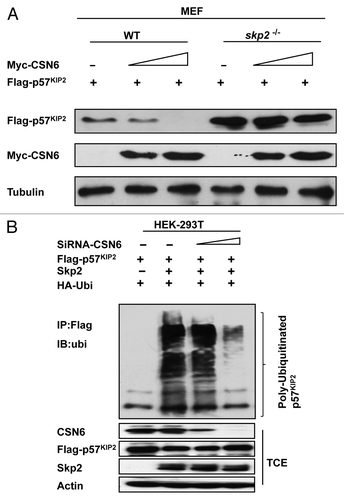
Figure 5. CSN6 impacts on p57 to regulate HER2-mediated cell proliferation, cell cycle progression and cell transformation. (A) p57 is induced in NIH3T3/HER2/tTA-p57 cell in the absence of tet. NIH3T3/HER2/tTA-p57 cells were treated with (+) or without (-) tet and the cell lysates were immunoblotted with indicated antibodies. (B) CSN6 expression antagonizes p57-mediated reduction of BrdU incorporation. NIH3T3/HER2/tTA-p57 cells were transfected with CSN6 and then treated without (-) tet. The cells were fixed for anti-BrdU staining. BrdU-positive cells were counted and presented as a bar graph. Error bars represent 95% confidence interval. (C) CSN6 expression hinders p57-mediated G1 arrest. NIH3T3/HER2/tTA-p57 cells were transfected with CSN6 and then treated without (-) tet. The cells were analyzed by FACS for cell cycle distribution. The percentages of each cell cycle phase are presented as a bar graph. Error bars represent 95% confidence interval. (D) CSN6 expression compromises p57-mediated inhibition of cell transformation. NIH3T3/HER2/tTA-p57 cells were transfected with CSN6 and then treated without (-) tet. The cells were analyzed for anchorage-independent growth by soft agar colony formation assay. The numbers of colony formation are presented as a bar graph.
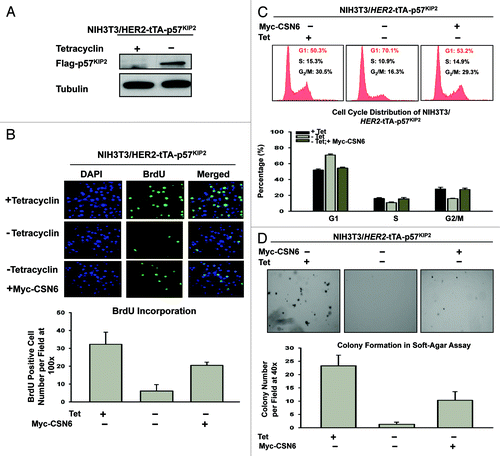
Figure 6. Expression levels of CSN6 and p57 in breast cancer samples and their correlations with survival. (A) A large percentage of breast cancer samples have high CSN6 and low p57. Cell lysates from 25 primary human breast cancer samples were immunoblotted with indicated antibodies. (B) Kaplan-Meier analysis showed that high expression of CSN6 and low expression of p57 were associated with poor overall survival. The expression levels of CSN6 and p57 were investigated by immunohistochemical staining, and were correlated with the overall survival rate. (C) Model of how CSN6-mediated p57 degradation affects cell proliferation, cell cycle progression and cell transformation.
